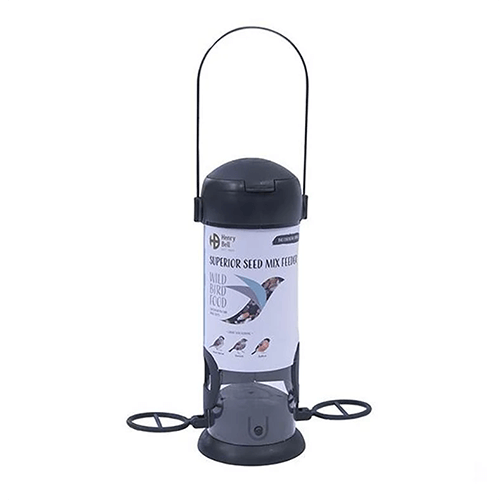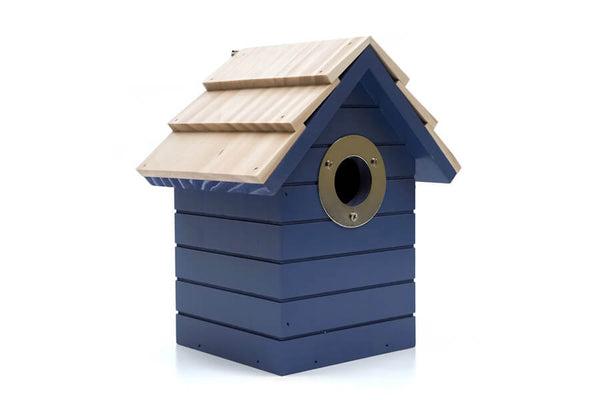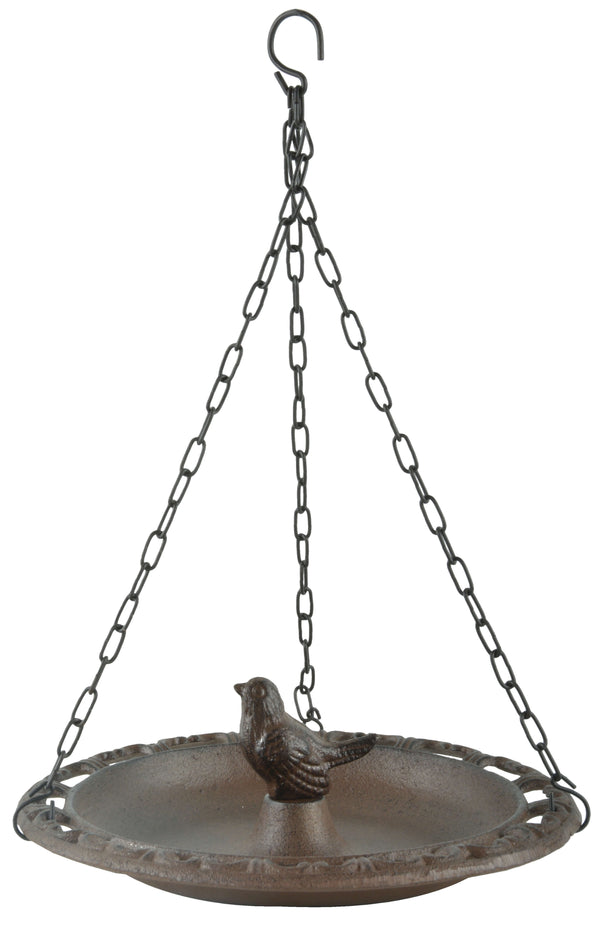Why are there no birds in my garden?
Wild birds are fascinating creatures that bring life, movement and joy to any garden. They provide colour, sounds, and are an essential part of any ecosystem. However, if you've noticed a lack of birds in your garden, it can be quite frustrating. In this article, we'll explore some of the most common reasons why there are no birds in your garden and offer tips on how to attract them back.
We have a separate article on how to attract wildlife to your garden, if you're looking for a wonderful place for wildlife and your feathered friends.
-
Lack of Food for Garden Birds
One of the primary reasons why birds might not be visiting your garden is that there is a lack of bird food. Birds are naturally attracted to areas with an abundant food source. If your garden doesn't have enough food for birds, they will simply go elsewhere.

To attract birds to your garden, you need to provide them with a variety of food sources. Consider adding bird feeders filled with seeds, suet, and other bird-friendly foods. You can also plant fruit-bearing trees and shrubs, such as blueberry bushes, to provide a natural source of food. Here are some examples of the types of natural food, that could be left out in your garden to attract birds:
-
Seeds & Bird Feeders:
Most bird species, such as finches and house sparrows, eat bird seeds as a primary food source. You can provide seeds by planting plants that produce seeds, such as sunflowers, or by placing bird feeders, seed feeders or bird tables that contain seed mixes. You'll generally attract many birds if you strategically place bird feeders around your garden. This article tells you where to place bird feeders in your garden.
-
Fruits:
Some bird species, such as orioles and thrushes, feed on fruits. You can provide fruit by planting fruit-bearing trees or shrubs in your garden, such as elderberry or serviceberry, or by placing fruit feeders.
-
Nectar:
Hummingbirds and other nectar-feeding birds require a source of nectar, which they obtain from flowers. You can attract these birds by planting nectar-rich flowers, such as bee balm or trumpet vine, or by providing a nectar feeder.
-
Insects:
Insect-eating birds, such as warblers and flycatchers, need a source of insects to feed themselves and their young. You can attract insects to your garden by planting flowers that attract pollinators, such as milkweed or coneflower, or by leaving dead wood or leaf litter on the ground to provide habitat for insects.
-
Suet:
Some bird species, such as woodpeckers and nuthatches, eat suet, a high-energy food made from animal fat. You can provide suet by placing suet feeders in your garden. You can also get special types of bird feeders that you can place Suet fat balls in.
In addition to providing food sources, it's also important to make sure that the food you provide is fresh and free of mold or contamination. Clean your feeders regularly, and replace any spoiled food immediately. By providing a variety of fresh, high-quality food sources, you can attract a diverse range of bird species to your garden.
When choosing a bird feeder, it's important to select one that's suitable for the birds in your area. Different birds have different feeding habits, and some feeders are better suited to certain species than others. For example, tube feeders are excellent for small birds such as finches, while platform feeders are ideal for larger birds of prey like cardinals.
-
Lack of Water for All The Birds !
Lack of water is another reason why birds may not visit your garden. Birds need water not only for drinking, but also for bathing and grooming their feathers. Without access to water, birds may not feel comfortable in your garden and may not consider it a suitable place to visit. Additionally, during hot and dry weather, water can be even more essential for birds' survival.
There are several things you can do to help provide water for birds in your garden:
-
Bird baths:
One option is to install a bird bath in your garden. Bird baths are shallow containers that are filled with water and placed on a pedestal or stand. They provide a source of fresh water for wild birds to drink and bathe in. Make sure to clean and refill the bird bath regularly to keep the water fresh.

-
Drippers and misters:
Another option is to install a water dripper or mister. These devices provide a slow, steady stream of water that all the birds can drink or bathe in. They can be attached to a bird bath or placed near plants or trees to create a natural-looking water source.
-
Ponds or water gardens:
If you have the space and resources, you can also consider installing a pond or water garden in your yard. These features not only provide water for birds, but also create a habitat for other wildlife, such as frogs and dragonflies.

-
Watering plants:
Finally, you can also help provide water for all the birds by watering your plants and lawn regularly. When you water your garden, you create puddles or small pools of water that birds can drink from.
By providing a source of water in your garden, you can help attract a variety of bird species and make your garden a more inviting and hospitable place for them to visit.
-
Lack of Shelter
First, let's talk about why shelter is important for birds. Birds need shelter for several reasons:
-
Protection from predators: Birds are vulnerable to predators, such as cats, hawks, and snakes. Having shelter, such as a birdhouse or natural cover like bushes and trees, gives birds a safe place to rest and hide.
-
Protection from the elements: Like humans, nearly all then birds need protection from the weather. During hot summer days, birds need shade to cool off, and during cold winter nights, they need shelter to keep warm.
-
Nesting: Birds need a safe place to build their nests and raise their young. Nesting boxes or birdhouses can provide a safe and comfortable nesting site for birds.

Now, let's talk about all the garden birds and types of shelter you can provide in your garden:
-
Bird houses:
Bird houses are a great way to provide shelter and nesting sites for birds. Different bird species have different preferences for the size and shape of their nesting boxes, so it's important to research which species are common in your area and what type of box they prefer.

-
Nesting boxes:
Nesting boxes are similar to birdhouses, but they are usually open on one side and designed for birds to build their own nests inside. Again, different bird species prefer different types of nest boxes, so research is key.

-
Roosting boxes:
Roosting boxes are designed to provide many birds with a place to rest and roost during cold weather. They are usually larger than nesting boxes and can accommodate several birds at once.
-
Natural shelter:
Shrubs, bushes, and trees can provide natural shelter for birds. They provide protection from the wind, rain, and sun, and can also provide nesting sites and perches for birds.
In addition to providing shelter, you can also attract birds to your garden by providing food and water sources. Bird feeders and bird baths are great ways to provide these resources.

Overall, providing shelter for birds is an important part of creating a bird-friendly garden. By providing the right type of shelter for adult birds, you can attract a variety of bird species to your garden and provide a safe and comfortable home for them.
-
Presence of Predators
Birds are naturally wary of predators, such as cats and hawks. If you have a lot of these predators in your area, birds will be less likely to visit your garden.
To reduce the presence of predators in your garden, consider keeping your cat indoors or installing a bird feeder that's out of reach of cats. You can also use bird netting to protect your garden from hawks and other predators.
-
Use of Pesticides
The use of pesticides can have a negative impact on bird populations in your garden. Pesticides are chemicals used to kill pests, such as insects, rodents, and weeds. When pesticides are used in your garden, they can have unintended consequences on the environment, including on bird populations.
Here are a few reasons why the use of pesticides can lead to a smaller bird population or lack of birds in your garden:
-
Pesticides can kill insects: Many bird species rely on insects as their primary source of food. When pesticides are used to kill insects, they can also kill birds that rely on those insects for bird food. This can lead to a decline in bird populations in your garden.
-
Pesticides can contaminate water sources: When pesticides are used in your garden, they can seep into the soil and contaminate water sources, such as streams and ponds. Birds that drink from these contaminated water sources can become sick or die.
-
Pesticides can reduce biodiversity: When pesticides are used in your garden, they can also kill beneficial insects and other organisms that are important for maintaining a healthy ecosystem. This can lead to a reduction in biodiversity and ultimately impact bird populations that rely on a diverse range of food sources.
To attract birds to your garden, it's important to use environmentally friendly pest control methods that do not harm bird populations. You can consider using natural pest control methods, such as companion planting or introducing natural predators, like ladybugs or praying mantises, to your garden. Additionally, planting a variety of native plants can help attract insects and other organisms that birds rely on for food. By using these methods, you can create a healthy and bird-friendly environment in your garden.

-
Lack of Diversity
A lack of diversity in your garden can mean there are no birds or fewer birds visiting your garden. Birds rely on a diverse range of food sources, nesting sites, and shelter to survive, and if your garden doesn't provide these resources, you may not see many birds.
Here are a few reasons why a lack of diversity can impact bird populations in your garden:
-
Lack of food sources: Birds rely on a diverse range of food sources, such as seeds, insects, fruits, and nectar. If your garden only has a few types of plants that do not provide these food sources, birds may not be attracted to your garden.
-
Lack of nesting sites: Birds need a variety of nesting sites to build their nests and raise their young. If your garden doesn't provide nesting sites, such as birdhouses or shrubs, birds may not choose to nest in your garden.
-
Lack of shelter: Birds need shelter to protect themselves from predators and the elements. If your garden doesn't have enough trees, bushes, or other structures for birds to shelter in, they may not feel safe in your garden.
To attract birds to your garden, it's important to provide a diverse range of food sources, nesting sites, and shelter. You can do this by planting a variety of native plants that provide different types of seeds, fruits, and nectar. You can also add birdhouses or nesting boxes to provide nesting sites, and plant trees and shrubs to provide natural shelter.
In addition to providing a diverse range of resources, it's also important to maintain your garden in a way that is bird-friendly. This means avoiding the use of pesticides and herbicides, providing clean water sources, and maintaining your garden in a way that provides a healthy environment for birds. By using natural food sources and creating a diverse and bird-friendly environment in your garden, you can attract a variety of bird species and create a thriving ecosystem.
-
Breading Season for Wild Birds
Breeding season can affect the number of birds you see in your garden in several ways:
-
Nesting: During breeding seasons, birds spend a lot of time and energy building nests, incubating eggs, and raising their young. This means that they may be less active in other areas, including visiting your garden.
-
Territory: Birds defend their territory during breeding seasons to protect their nesting sites and ensure their young have access to food and resources. This means that they may be less likely to venture into your garden if they consider it outside of their territory.
-
Migration: Some bird species migrate during breeding seasons to areas with more suitable breeding conditions, which could mean that the number of birds in your garden temporarily decreases.
-
Shyness: During breeding seasons, some birds can become more shy and cautious to avoid attracting predators to their nesting sites. This means they may be less likely to visit areas with human activity, including your garden.
It's important to note that not all bird species breed at the same time, and some may not be affected by breeding seasons in the same way. Therefore, the absence of birds in your garden during breeding seasons may be temporary and may depend on the specific species in your area.











